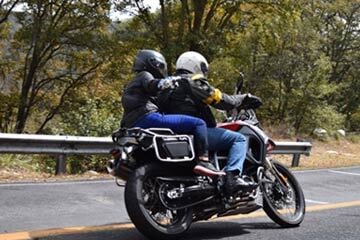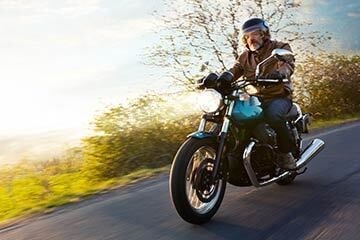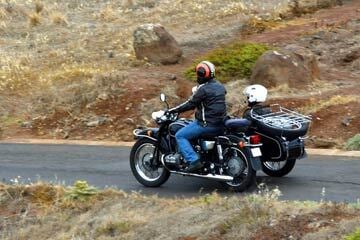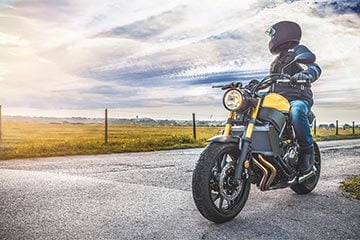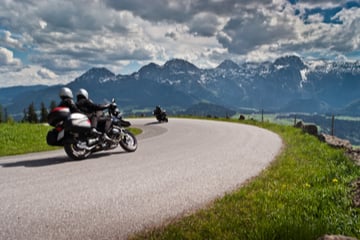How much is insurance for a Harley-Davidson?
The average price of Harley Davidson motorbike insurance is £255*.
Motorcycle insurance tends to get cheaper as you get older. From an insurer’s point of view, older riders tend to be more experienced and are less likely to have an accident. But age is just one of multiple factors that affect the price of your insurance.
What affects the price of motorbike insurance?
The factors that affect the cost of insurance include:
- Your age
- Where you live
- Your riding history
- The size of your motorbike's engine
- The value of your motorbike
Your age is an important factor as the older and more experienced you are, the less you can expect to pay for your policy.
Where you live also affects how much your insurance costs. If you live in an area with low car crime rates, it's considered safer and insurers reflect that in lower prices.
Your riding history. If your driving record has no penalty points or driving convictions, you can expect to see lower insurance costs.
The size of your motorbike's engine determines which motorbike insurance group it's placed in. These are ranked 1 - 17 or sometimes up to 22. The higher the group, the riskier your motorbike is considered and the more you can expect to pay.
The value of your motorbike. The more your motorcycle costs, the more insurers charge for your policy. This is because of the higher cost of repair or replacement if you're involved in an accident.
Make sure all the details you put in are accurate or it may invalidate your insurance.
How can I save on my Harley-Davidson motorcycle insurance?
- Improve your motorbike security
- Increase your voluntary excess
- Build your no-claims bonus (NCB)
- Compare quotes
- Pay annually
- Choose a less powerful motorbike
Increase your motorbike security. You can do this by adding an alarm or an immobiliser to your Harley-Davidson. You can also store your motorcycle in a locked shed or garage to help lower your insurance costs further.
Increase your voluntary excess. The amount of voluntary excess you pay could help you keep costs down. A higher excess could indicate to insurers that you're only likely to make a claim if you're involved in a serious accident. Make sure you're able to afford this amount if you were to make a claim, though.
Build your no-claims bonus (NCB). Building your NCB shows insurers that you're less likely to make a claim. The more NCB you build, the more of a discount you're likely to get.
Compare quotes. By using us to compare Harley-Davidson motorbike insurance, you can compare quotes from multiple providers to make sure you find the best deal for you.
Pay annually. Paying monthly might seem attractive but you could end up paying more overall. Avoid paying monthly interest and admin fees by paying for your motorbike insurance annually.
Choose a less powerful motorbike. Lower spec motorbikes tend to be placed in lower insurance groups, meaning they're considered less risky by insurers and therefore are cheaper to insure.
History of Harley-Davidson
Even for non-motorcycle enthusiasts the name and badge of Harley-Davidson is iconic.
Classic films like 1969’s Easy Rider helped reinforce Harley-Davidson’s iconic status as a motorcycle manufacturer. The customised Harley-Davidson choppers used in the film compete with stars Jack Nicholson, Dennis Hopper and Peter Fonda for top billing.
Although the manufacturer has a particularly glamorous reputation, its origins are actually quite humble.
In 1903, William Harley and Arthur Davidson built the prototype for their company’s first motorcycle. They finished the motorbike the same year but, not happy with that design, they immediately began work on a bigger engine.
By 1905 the first production bike, the Harley-Davidson Model No 1, was released. A year later the first Harley-Davidson factory was built on Chestnut Street in Milwaukee.
In 1917, around 50% of Harley’s sales went to the US armed forces. After the end of the First World War, Harley-Davidson continued to grow its business. It completed its 7-storey-high facility on Juneau Avenue in 1920 - which still serves the company its corporate head office to this day.
The 1920s was a significant decade for Harley-Davidson because the JD model launched in 1925. It incorporated a fuel tank with the distinctive rounded, teardrop shape that's been associated with the brand ever since.
One of the few US motorcycle manufacturers to survive the Great Depression of the late 20s and early 30s, Harley-Davidson was able to continue building and developing motorbikes.
The US participation in the Second World War saw Harley-Davidson produce an estimated 88,000 motorcycles for the US military between 1941 and 1945.
It's not just the US Army that Harley-Davidson has impressed over the years. Harley motorbikes are used by the California Highway Patrol and can be found in over 3,400 police departments in the US and in 45 countries.
In addition to its US production, Harley-Davidson now makes motorbikes across the world in India, Brazil and more recently Thailand.

